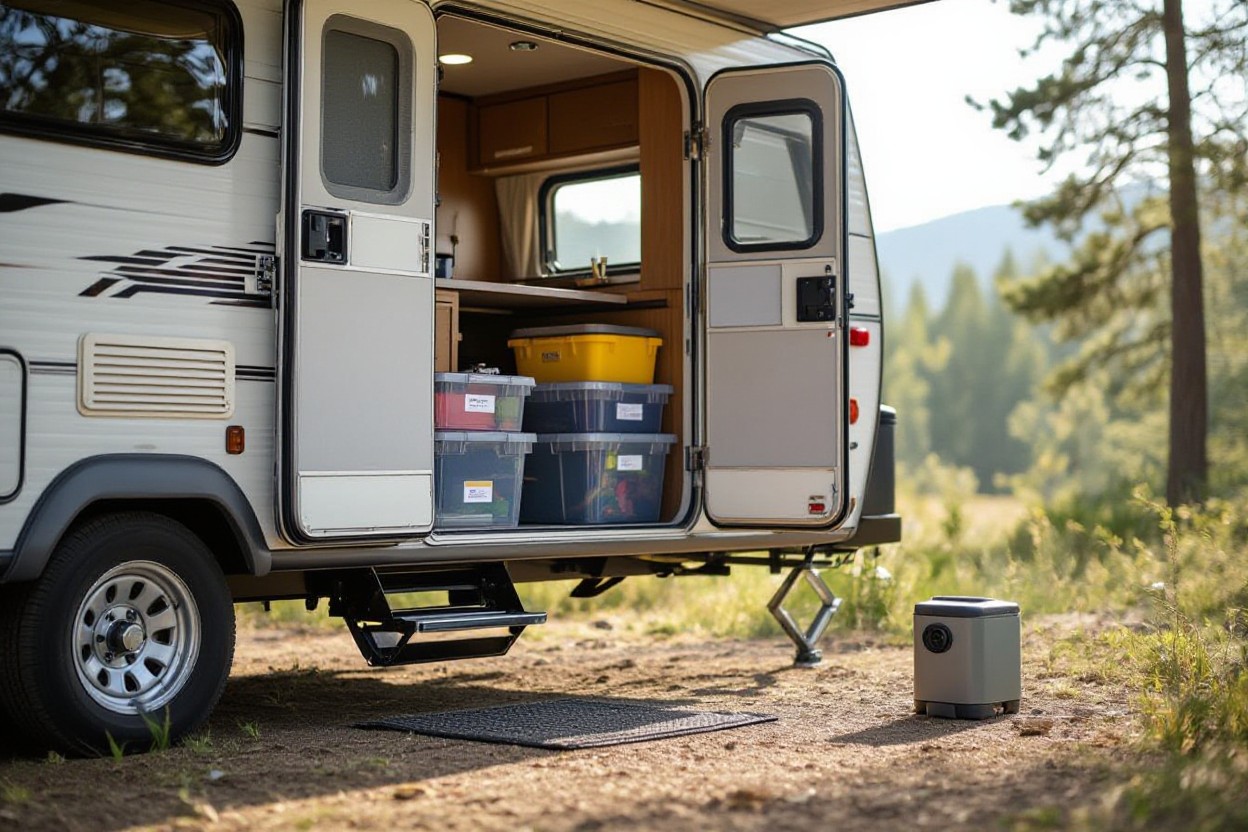Over the years, I have discovered how invasive mice can be when they find a cozy camper to call home. Not only do these tiny intruders cause damage to your wiring and insulation, but they also pose health risks with their droppings. In this guide, I will share simple, effective methods you can use to protect your camper from these unwelcome guests, ensuring your travels stay safe, comfortable, and mouse-free.

Crafting a Fortress: Securing Your Camper Against Rodents
After identifying spots inviting to mice, reinforcing your camper’s defenses becomes a top priority. By focusing on fortifying weak points and employing targeted sealants, you’ll significantly reduce the chance of rodents infiltrating your living space. This proactive approach not only protects your camper from damage but also saves you from costly repairs and health risks linked to infestations.
Identifying Vulnerabilities: Common Entry Points for Mice
Rodents often slip in through gaps as narrow as 1/4 inch, sneaking into compartments around plumbing, vents, and the undercarriage. Pay special attention to weather stripping, utility lines, and cracked window seals—these act as welcome mats. Checking underneath the camper, especially near axles and chassis joints, can reveal often-overlooked breaches mice exploit.
Reinforcing Entryways: Effective Sealing Techniques
Applying pest-proof sealants such as copper mesh combined with high-grade silicone caulk fortifies vulnerable gaps effectively. I recommend clearing debris, filling voids with steel wool, then sealing with a robust caulk designed for outdoor use. This layered defense blocks mice from gnawing through, creating a durable barrier against intrusions lasting through harsh weather conditions.
Steel wool works as an initial plug because mice can’t chew through its coarse texture, while copper mesh reinforces larger gaps with flexibility and rodent resistance. To ensure longevity, opt for caulks rated for UV exposure and moisture resistance, as outdoor seals degrade quickly without these properties. Overlapping techniques—like using expandable foam covered by a hard sealant—add extra toughness, especially around irregular or hard-to-reach areas. These combined methods create an impenetrable shield crucial for maintaining a pest-free camper environment.
The Scent of Safety: Natural Deterrents and Repellents
Using natural scents can create an invisible barrier deterring mice from making a home inside your camper. Strong aromas like peppermint, eucalyptus, and cayenne pepper are known for their ability to overwhelm a mouse’s sensitive nose, driving them away without harmful chemicals. You can place cotton balls soaked in imperative oils strategically around entry points or sprinkle dried herbs in corners. These natural deterrents are not only effective but also safe for you and your pets, making them ideal for maintaining a fresh, inviting living space without unwanted visitors.
Essential Oils and Other Natural Remedies
Peppermint oil is one of the most popular natural mouse repellents because mice find its strong scent unbearable. Applying it on cotton balls near windows, vents, and doorways can reduce mouse activity significantly. Mixing imperative oils like clove, citronella, and eucalyptus enhances the effect. In addition, garlic and vinegar sprayed in corners have shown promising results by disrupting the mice’s scent trails. These remedies require regular refreshing—about every few days to a week—to maintain their potency, but they offer a chemical-free solution with minimal effort.
Store-Bought Solutions: What Works Best?
Among commercial options, ultrasonic repellents and bait stations top the list for camper use. Ultrasonic devices emit high-frequency sounds that disturb rodents without disturbing humans or pets, providing a non-toxic solution. Bait stations containing rodenticides can be effective but must be placed carefully to avoid accidental exposure. Glue traps are another choice, though they require daily checks and raise ethical concerns. Choosing products with proven track records and reading user reviews can guide you towards effective, safe options tailored for camper environments.
Products like Victor ultrasonic pest repellers boast coverage up to 800 square feet and several independent studies have demonstrated a measurable decline in rodent activity within two weeks of continuous use. Bait stations using anticoagulants, such as bromadiolone, act slowly to reduce risk of secondary poisoning. Combining ultrasonic repellents with live traps often yields the best results by both discouraging entry and catching persistent invaders. Always ensure any product placement keeps children and pets out of reach, and follow manufacturer guidelines meticulously to maintain safety and effectiveness.
Evicting Unwanted Guests: Trapping Strategies that Work
When the scent barriers don’t fully discourage mice, using traps becomes the next effective step. I’ve found that a well-chosen and strategically placed trap can significantly reduce mouse activity inside your camper. Combining traps with natural repellents creates a layered defense, increasing the chances of quickly evicting these persistent invaders. Prioritize humane options where possible to catch and release, but don’t overlook snap traps for immediate and reliable elimination.
Choosing the Right Type of Trap
Snap traps remain my go-to for rapid and effective mouse removal, especially in confined camper spaces. For those preferring a humane approach, live traps offer catch-and-release options, but they demand daily checking to prevent harm. Glue boards, while simple, pose ethical concerns and can be messy, so I use them sparingly. A combination of trap types often improves success rates, meeting different needs depending on infestation size and your comfort level with handling captured mice.
Placement and Monitoring for Maximum Effectiveness
Positioning traps along walls, behind appliances, and near dark corners where you notice droppings or gnaw marks ups effectiveness. Mouse pathways usually hug edges, so placing baited traps perpendicular to these routes improves catch rates. Consistent monitoring, ideally every 12 hours, allows quick removal and resets traps before losing their allure. Fresh bait—peanut butter is my favorite—is imperative for ongoing success.
To optimize placement, focus traps within 10 feet of identified entry points and nesting sites as mice rarely stray far from food sources. I recommend setting multiple traps spaced 2 to 3 feet apart, ensuring coverage of the most trafficked nodes inside your camper. Maintaining cleanliness around traps prevents scent contamination that could deter cautious mice, and using gloves when handling traps minimizes human scent, which some studies suggest mice detect and avoid.

Maintenance and Prevention: Long-Term Strategies for Rodent-Free Camping
Regular upkeep, like sealing even the tiniest cracks with steel wool and high-quality silicone caulk, keeps mice from sneaking inside your camper. Routinely cleaning and decluttering storage areas removes tempting nesting spots. I also recommend checking vents, door seals, and undercarriage insulation, since rodents exploit these weak points. Investing in rodent-proof storage bins and setting traps in hidden corners has kept my rig mouse-free season after season. These methods work together to build a strong, ongoing defense that saves headaches later.
Seasonal Checklists: What to Do Before Storing Your Camper
Before tucking your camper away for the season, I go through a detailed checklist: cleaning food debris, emptying all cabinets and compartments, and placing rodent deterrents like peppermint oil-soaked cotton balls around entry points. Draining water lines and inspecting for damage prevents moisture buildup, which attracts pests. I also carefully inspect wheel wells and undercarriage insulation for signs of past rodent activity and repair or replace materials as needed. These steps minimize the risk of unwelcome guests during months of dormancy.
Best Practices for Keeping Rodents at Bay During Use
While actively using your camper, consistent housekeeping is key—wiping crumbs and not leaving food exposed dramatically reduces attractants. I recommend storing all edibles in airtight, heavy-duty containers rather than typical plastic bags. Installing fine mesh screens on vents and using UV-resistant rodent repellents around doors maintains barriers against intrusion. Frequent inspection of high-risk zones, especially overnight, helps detect early signs of rodent presence so you can act fast.
Digging deeper into best practices for preventing rodents during camping trips, I’ve found that combining physical barriers with environmental strategies offers the strongest protection. For example, layering heavy-duty door sweeps and rodent-proof vent covers physically blocks entry, while deploying natural repellents like peppermint or eucalyptus oil disrupts rodents’ instincts to nest nearby. I also make it a habit to camp on elevated or gravel surfaces rather than grass or dense foliage, which reduces rodent populations around my camper. These layered tactics make a significant difference in keeping mice at bay during extended adventures.

When to Call in the Professionals: Signs You Need Expert Help
Sometimes, despite your best efforts with traps and deterrents, mice continue to lurk in your camper. Persistent droppings in multiple areas, chewed wiring, or a sudden increase in scratching noises after dark are telltale signs you might be dealing with more than just a few guests. When these issues escalate, it often signals an infestation that requires professional intervention to protect your vehicle’s integrity and your health.
Recognizing Severe Infestations
A severe infestation typically shows up as numerous droppings—over 50 in a single sweep—nesting material tucked behind panels, and visible damage to insulation or wiring. If you notice mice actively breeding in your camper or signs of contamination on stored food, it’s more than a nuisance; it’s a severe invasion needing immediate, expert action to prevent costly repairs and health risks.
Evaluating Pest Control Services
Selecting a pest control service means weighing their experience with camper-specific infestations, the types of treatments they use, and their approach to eco-friendly options. Services that offer integrated pest management and follow-up inspections often provide the best outcomes, ensuring mice are eliminated and won’t return.
When choosing pest control, look for companies specializing in recreational vehicle treatments. I recommend verifying their certifications and reviews for success stories involving campers or RVs. Ask about the chemicals used, their safety around protected materials, and if they provide a warranty or follow-up visits. Professionals who explain their process and tailor plans to your camper’s unique features can save you money and hassle in the long run.
To wrap up
Conclusively, I’ve found that keeping mice out of your camper the easy way involves consistent prevention methods like sealing all entry points, maintaining cleanliness, and using natural repellents. You can protect your camper by focusing on these simple steps regularly. By staying vigilant and proactive, you’ll avoid the hassle of dealing with unwanted rodents and keep your living space comfortable and safe during every adventure you initiate on.




Leave a comment